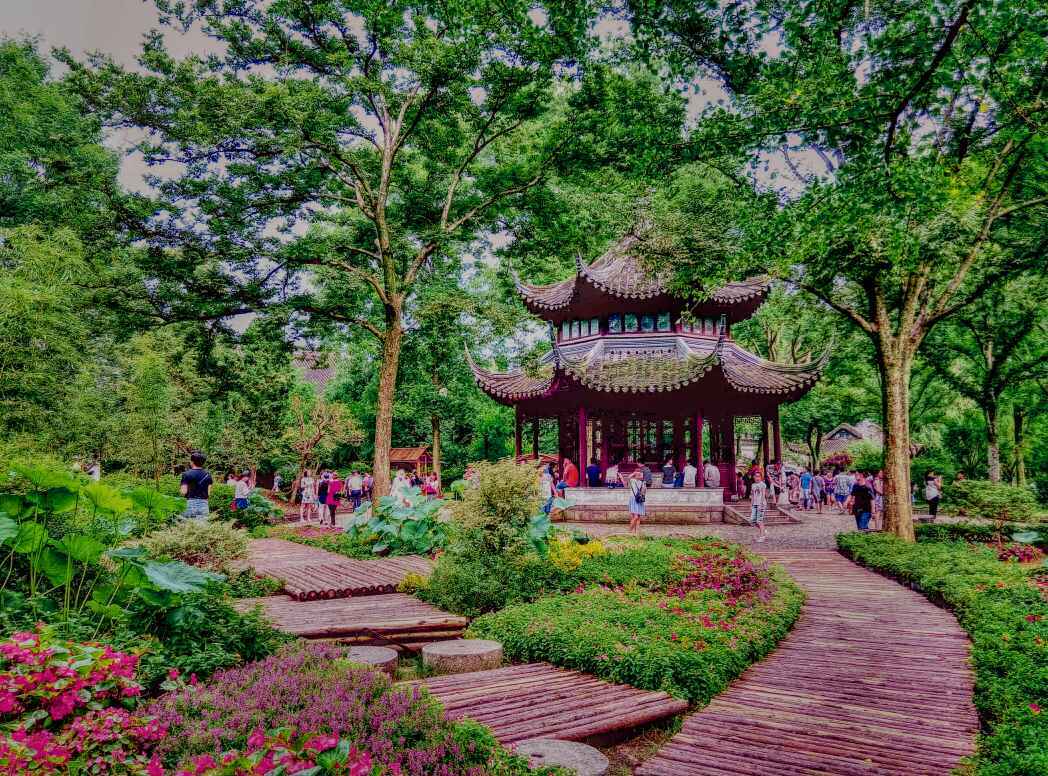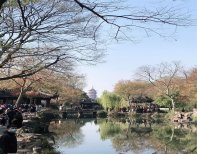亲爱的游客朋友,今天澄海cc网陪您游览的是大名鼎鼎的苏州拙政园,这可是个风景如画的地方。
苏州拙政园始建于明正德初年(16世纪初),距今已有500多年历史,是江南古典园林的代表作品。
1961年被国务院列为全国第一批重点文物保护单位,与北京颐和园、承德避暑山庄、苏州留园一起被誉为中国四大名园。
1991年被国家计委、旅游局、建设部列为国家级特殊游览参观点。
1997年作为苏州古典园林的典型例证,被联合国教科文组织列入《世界遗产名录》。
2007年又进入全国首批5A景点行列。
拙政园位于古城苏州东北隅(东北街178号),是苏州现存的最大的古典园林,占地78亩(约合5.2公顷)。
建园艺术以水见长,自然典雅,庭院错落,花木为胜。
明朝御史王献臣是拙政园的第一位园主,他因官场失意还乡后建造此园,取晋代潘岳《闲居赋》中“拙者之为政也”句意命名。
当时园中有若墅堂、梦隐楼等31景,茂树曲池,胜甲吴下。
嘉靖十二年(1533年),著名画家文徵明依园中景物绘图31幅,各写诗一首,并作《王氏拙政园记》。
拙政园建园以来,分分合合,时兴时衰,园主多次变换。
明崇祯四年(1631),园东部被侍郎王心一购得建归田园居,拙政园至此一分为二。
清乾隆初,园中、西部又分为复园和书园两部分。
复园归太守蒋棨(qǐ)所有,蒋氏经营多年,恢复其旧观。
书园的园主是太史叶士宽,园内有拥书阁、读书轩、行书廊、浇书亭等景点。
从那时起,统一规划、浑然一体的拙政园演变为相互分离、自成格局的三个园林。
咸丰十年(1860)太平天国忠王李秀成在此修建王府。
府中琼楼玉宇,曲栏洞房,犹如神仙窟宅。
同治二年(1863)忠王府遭李鸿章占据,被设为江苏巡抚行辕,同治十一年(1872),园中部为八旗奉直会馆。
光绪三年(1877)园西部属张履谦补园,园东部其时已渐见荒芜。
讲解到这里,您已经大致了解了拙政园的历史发展脉络,下面就让澄海cc网再为您仔细介绍一下组成拙政园的东、中、西三个花园吧。
拙政园的东花园开阔疏朗,中花园是全园精华所在,而西花园建筑精美,它们各具特色。
拙政园中部是拙政园的主景区,为精华所在。
面积约18.5亩。
虽历经变迁,与早期拙政园有较大变化和差异,但园林以水为主,池中堆山,环池布置堂、榭、亭、轩,基本上延续了明代的格局。
拙政园东花园的面积约31亩,其规模大致以明朝王心一所设计的“归园田居”为主,居中为涵青池,池北为主要建筑兰雪堂,周围以桂、梅、竹屏之。
池南及池左,有缀云峰、联壁峰。
兰雪堂之西,梧桐参差,茂林修竹,溪涧环绕。
北部系紫罗山、漾荡池。
东甫为荷花池,面积达四五亩,家田种秫,皆在望中。
拙政园西园原为“补园”,面积约12.5亩,现有布局形成于张履谦接手时期。
该园以池水为中心,有曲折水面和中区大池相接。
其水面迂回,布局紧凑,依山傍水建以亭阁。
因被大加改建,所以乾隆后形成的精巧、造作的艺术风格占了上风,但水石部分同中部景区仍较接近,那起伏、曲折、凌波而过的水廊、溪涧则是苏州园林造园艺术的佳作。
装修精致奢丽。
其中,建筑以南侧的鸳鸯厅为最大。
听过这些介绍,想必您对拙政园已经有一个大概的印象了,下面就请跟我一起走进这座江南园林的代表,去亲眼感受、亲身体会它的美吧。
Dear friend, today the little donkey will accompany you to visit the famous Humble Administrator’s Garden in Suzhou, which is picturesque. Built in the first year of emperor Zhengde’s reign in Ming dynasty (early sixteenth century), it has a history of more than five hundred years. The Humble Administrator’s Garden of Suzhou is a representative work of the Jiangnan classical gardens. In 1961, it was listed in the first batch of national key cultural heritage protective units by the State Council and was honored as the China’s four famous gardens, together with Beijing Summer Palace, Chengde Mountain Resort and Suzhou Lingering Garden. In 1991, it was honored as a national special tourist spot by the National Planning Commission, the Tourist Bureau and the Ministry of Construction. In 1997, as a typical example of the classical garden in Suzhou, it was registered in the World Cultural Heritage by UNESCO. And in 2007, it became the first batch of 5A scenic spots in China.
The Humble Administrator’s Garden is located in the No.178 Northeast Street in Suzhou City, it is the largest and most renowned classical garden in Suzhou, covering an area of 78 Mu (about 5.2 hectares). With water as its forte, the constructive art of the garden is natural and classical. The courtyards are well-arranged, flowers and trees are wonderful. The court supervisor Wang Xianchen of Ming dynasty was the first owner of the Humble Administrator’s Garden, he built the garden when he returned home after his failure in the official career; the garden was named from a sentence in Pan Yue’s poem Ode to Idleness in Jin dynasty :a humble and clumsy man who deals with politics. At that time, in the garden, there were 31 scenic spots, such as villa-like Hall and Dream hiding building; trees were luxuriant and ponds were crooked, which were very famous and elegant in the eastern land. In the 12th year of Emperor Jiajing’s reign (1533), the famous painter Wen Zhengming painted 31 paintings according to different scenic spots in the garden, composed poems for each scenery and wrote an article named A Note to the Humble Administrator’s Garden of Wang.
Since the Humble Administrator’s Garden was established, it has gone through separations and combinations as well as rises and falls, and the owner of the garden also switched several times. In thr 4th year of Emperor Chongzhen’s reign in Ming Dynasty (1631), the eastern part of the garden was purchased by the assistant minister Wang Zhongyi and was built as a rustic retirement home for himself, the garden therefore was divided into two parts. In the early years of Emperor Qianlong’s reign, the central and western parts of the garden were divided into two parts: named Fu Garden and Book Garden respectively. Fu Garden was owned by the prefecture chief Jiang Qi, his family has owned it for years and restored its old view. The owner of Book Garden was the court historian Ye Shikuan, and in the garden, there were some scenic spots such as Book Embracing Pavilion, Book Reading Veranda, Calligraphy Corridor and Book Irrigating Pavilion. Since then, the united and integrated Humble Administrator’s Garden had evolved into three self-formative gardens.
In 10th year of Emperor Xianfeng’s reign (1860), Prince Zhong of the Taiping Heavenly Kingdom, named Li Xiucheng, built his palace here. There were many sumptuous dwellings in the palace which is like the fairyland. In the second year of Emperor Tongzhi’s reign (1863), the palace of Prince Zhong was occupied by Li Hongzhang and was set as a temporary office of the grand coordinators in Jiangsu. In 10th year of Emperor Tongzhi’s reign (1872), the Central Section was set to be the Eight Banners’ hall. In 3th year of Emperor Guangxu’s reign (1877), the Western Section belonged to Zhang Lvqian and was named as Bu Garden, and the Eastern Section gradually became deserted.
After my previous introduction, you may have roughly understood the historical development of the Humble Administrator’s Garden, next let your little donkey introduce the three gardens in eastern, central and western sections respectively to you carefully. The eastern garden is wide and bright, the central one is the essence of the whole garden, while the western one has exquisite architectures, therefore three gardens are all characteristic.
The central section is the main scenic area and the essence of the Humble Administrator’s Garden, covering an area of about 18.5 Mu. Although the central section has gone through great changes and has large differences with the garden in an earlier period, it now is mainly composed by water; artificial mountains rise in ponds which are surrounded by halls, pavilions and verandas, such layout basically inherits the style in Ming Dynasty.
The eastern garden covers an area of about 31 Mu, whose layout mainly bases on the style named “residence after retire" designed by Wang Xinyi in Ming Dynasty. The middle of which is the Green Containing Pool, and the main building named Orchid and Snow Hall was built in the north of the pool which is surrounded by Osmanthus, prunes and bamboos. In south and left of the pool, there are the Cloud Dotted Peak and Cliff Connected Peak. In west of the Orchid and Snow Hall, there are irregular phoenix trees, flourishing woods and tall bamboos. Creeks and ravines also encircle the hall. In north of the Orchid and Snow Hall, there are Ziluo Mountain and Yangdang Pool. In east of the Orchid and Snow Hall, there is a lotus pond which covers an area of four to five Mu. Farmlands and sorghum are all in your sight.
The Western Section of the Humble Administrator’s Garden was originally named as “Bu Garden”. It covers an area of 12.5 Mu and its present layout was formed in Zhang LvQian period. With pools in the center, winding water connects to the central large pool. The surface of the water is circuitous, the layout is compact and this place is located at the foot of a hill and beside a pool to build pavilions around. Due to great reconstruction, the exquisite and artificial artistic style prevailed after Emperor Qianlong’s reign. However, the scenery of waters and stones is still similar with the view of the Central Section. The wavy and winding water corridors and mountain streams are the masterpiece within the Suzhou classical garden art. The decoration here is exquisite and luxurious. Among them, the Mandarin duck hall at the south side is the largest.
After listening to the previous introduction, I guess you may already have a general impression on the Humble Administrator's Garden, then please follow me to walk into the representative of Jiangnan classical garden and enjoy its beauty with you own eyes.
景区内部景点:
别有洞天、波形廊、倒影楼、待霜亭、东门、浮翠阁、芙蓉榭、荷风四面亭、海棠春坞、涵青亭、见山楼、嘉实亭、留听阁、笠亭、绿漪亭、玲珑馆、兰雪堂、评弹演出室、盆景园、十八曼陀罗花馆、卅六鸳鸯馆、松风水阁、秫香馆、塔影亭、听雨轩、天泉亭、梧竹幽居、雪香云蔚亭、香洲、小飞虹、小沧浪、绣绮亭、倚虹亭、宜两亭、玉兰堂、与谁同坐轩、倚玉轩、远香堂、缀云峰、拙政园
景区开放时间:
7:30-17:30(3月1日-11月15日)
7:30-17:00(11月16日-次年2月29日)



 9
9 01/17
01/17
 9
9 09/27
09/27






